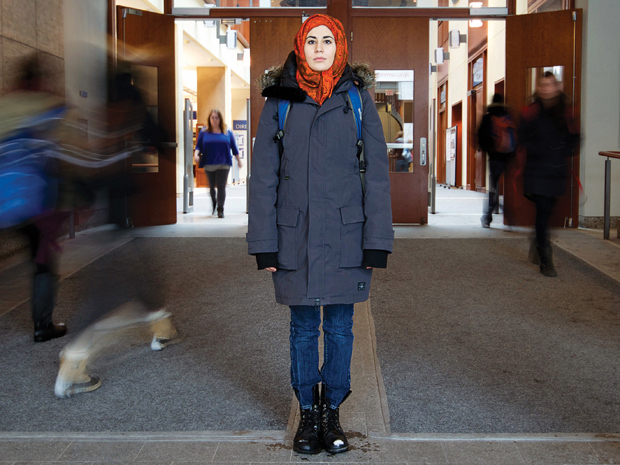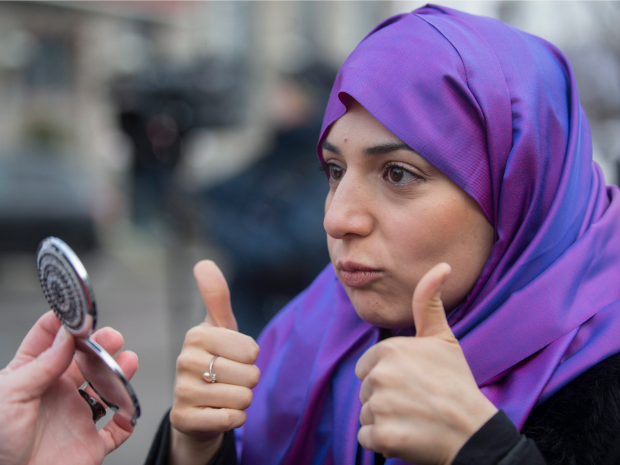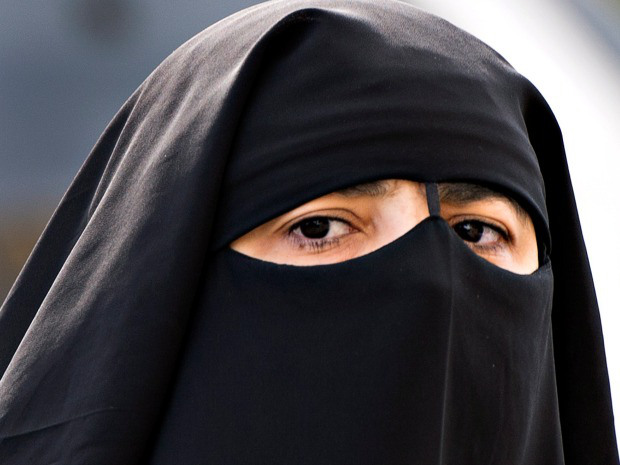Jonathan Kay: The space between the hijab and niqab is where our anxieties lie
Jonathan Kay | March 28, 2014 |
Queen's University student ANISA RAWHANI wore a hijab to gage reaction and understand the experience of wearing one.
Canadians may well be the world’s leaders in the journalistic cottage industry of dressing up Muslim. Seven years ago, a Huffington Post editor put on a burka for a week, and attempted to play it for laughs in a piece titled “Does This Burka Make Me Look Fat?” Last year, Quebec’s favourite hothead, Richard Martineau, wore a burka on his French-language rantfest, “Franchement Martineau” — mirroring a stunt performed by Sun News personality Ezra Levant, who pronounced the garment “bloody uncomfortable” before ripping it off after a minute or two. His Sun colleague, David “The Menzoid” Menzies, put a Burka on a 14-year-old child and filmed him buying 24 ounces of hard stuff at an Ontario liquor store.
The latest installment in this genre comes courtesy of Queen’s Journal copy editor Anisa Rawhani, a young non-Muslim woman who wore a hijab (a veil that covers the head and chest, but leaves most of the face exposed) for 18 days to see how people would react. Unlike the above-mentioned stunts, Rawhani’s journalism seems to have been motivated primarily by genuine sociological curiosity.
The Queen’s University campus and its Kingston, Ont. environs are full of well-educated liberals. So right off the bat, Rawahani tells us, “I suspected I wouldn’t be the target of racial slurs, threats or ill-treatment.” And indeed, she wasn’t. Just the opposite: “If anything, people were being nicer . Much nicer.”

At first I thought I was just imagining things,” she writes. “So what if strangers smiled at me in the street? [But] you can imagine my surprise when I realized that the friendlier-than-usual interactions — with friends and strangers alike — were by no means unique episodes, but a common theme. I started to experience instances where I was treated in a noticeably different manner from others.” She supplies one vivid example from a low-rent pizzeria “where the man on cash wasn’t in the best mood.” He treated Rawhani’s friends with disdain when they asked him for condiments, but “smiled broadly” when serving the hijabbed author.
The only awkwardness that crept into the experiment unfolded when Rawhani put up her hand in class, and a teacher mistakenly called on her using the name of the class’ one other hijab-wearing student (who happened to be absent). As one might expect in this day and age, the professor was mortified by his error, and made a great show of apologizing. To her great credit, Rawhani describes the incident matter-of-factly, and does not seize on it as an indicator of seething racism. (Given the way these incidents often are treated by campus star chambers, the professor no doubt was terrified that he would spend the next few years of his life being investigated for thoughtcrime.)
What explains the extremely non-Islamophobic — indeed, outright Islamophillic — response to Rawhani’s hijab? She puts that question to Leandre Fabrigar, a Queen’s psychology professor who specializes in the study of “attitude and persuasion.” Fabrigar describes the phenomenon as one of “impression management”: Most of us realize we may be bigots, but our rational minds tell us that this bigotry is wrong. So we “engage in an overcorrection process, which, ironically, would then lead [us] to be more friendly to the minority member than others.”
That sounds plausible to me, as does most of Rawhani’s own sociological speculation. Still, it left me wondering whether the nature of the author’s experiment allowed her to dodge the real concerns that even non-bigotted Canadians have about socially conservative Muslims. Hijab or not, Rawhani presented herself to the world as what she apparently is: a modern, confident, well-integrated, socially engaged young woman who attends college, goes out on weekends with her friends, and works for a student newspaper. If this is your way of interacting with the world, what difference does a headscarf make?
Rawhani’s pizza example hit home for me. Last weekend, I happened to be enjoying a glutinous late-night meal at Angela’s Pizzeria on Montreal’s de Maisonneuve Blvd., when a gaggle of hijabbed women came in and began carrying on in Arabic while feasting on fries and a veggie pie. (This area has had a large young Arab contingent for several decades now.) In the manner typical of all teenagers, they babbled at each other incessantly while ignoring anyone over the age of 20 who wasn’t serving them food. In the way they presented themselves to the world, they might as well have been French-Canadians, or Anglos, or Jews, or Greeks, or Italians. The hijabs changed nothing.
Where things become more complicated is when a Muslim woman ups the ante by exchanging the hijab for the full face mask of the niqab (or, when combined with body covering, a burka). You do see some women like this in large Canadian cities (though not a hundredth as many as one might think from reading the commentary of certain overheated culture warriors). But they are never (by my observation) having a rollicking good time in pizzerias. Instead, they are more apt to be traveling silently on the subway with a baby carriage, or unobtrusively taking notes in the back of a trade-college classroom.

This is not to say that the niqab is a complete social death sentence. Travel along Overlea Blvd, through the commercial heart of Toronto’s heavily Muslim Thorncliffe Park neighbourhood, and you will see women in Burkas traveling in groups, talking with one another, doing their shopping at East York Town Centre, or dropping their children off at school. But socially, it’s a closed shop: The face covering sends the clear message that they conceive of the world around them to be largely one of leering men and other vulgar social contaminants, against which they must protect every inch of their body — except an eye-slit just big enough to make sure they don’t bump into cars and lampposts.
Islamic fundamentalists claim that niqabbed women do so out of their own free will, rather than the threat of a beating by their husband. But even if that is so, their “free will” obviously is informed by a paranoid and highly regressive understanding of women’s place in society. And it is perfectly understandable — and not in any way “Islamophobic” — that ordinary Canadians (including Levant, Martineau and The Menzoid) would be creeped out by it.
Eighteen days would be a long time to wear a niqab. But I’d be interested to hear the results if Rawhani were interested in repeating her experiment, but this time in full face covering as opposed to a mere headscarf.
I’d be interested to hear the results if Rawhani repeated her experiment, but this time in full face covering as opposed to a mere headscarf
My guess is that she would find, once again, that people would be perfectly civil to her. But I suspect that this friendliness would come from a different, much more anxious place.
One of the effects of the niqab is that it strips away all of the informal social cues that we typically rely on when we talk to people: the smiles, raised eyebrows, furrowed brows and such that tell us if our jokes are funny or not, our stories interesting or not, our presence welcome or not. The Burqa signals to the non-burqa-wearer that, to the extent he is capable of arousing any emotion at all, it is of the negative variety. In such a situation, most of us non-burqa folks are likely to put on a nervous smile, say something harmless, and get any necessary social or commercial interaction over with as quickly as possible so as not to induce the fear of sexual predation that, the niqab’s existence implicitly signals, is but thinly suppressed in all of us.
Since 9/11, all Western societies have become obsessed with the way Muslim women dress. (Indeed, in parts of Quebec, it has become a sort of full-blown neurosis.) But Rawhani misunderstands the issue if she thinks that this is really about the hijab. It is about our basic, socially felt human need to see the faces of those we interact with. The fact that we politely tolerate those who live behind masks bespeaks Canadian civility. But it does not mean the underlying practice is in any way healthy or desirable.
National Post
• Email: jkay@nationalpost.com
Source
Commentary by the Ottawa Mens Centre
Men in Canada don't need to dress in any religious attire to be subject to Canadian Male Sharia Law that is the practical reality of perhaps a country with one of the most corrupt man hating systems of Justice imaginable.
The Canadian Extreme Feminists received truck loads of Federal and Provincial tax money to fund what are commonly called "One Stop Divorce Shops" and other state funded or operated institutions whose primary role is promote hatred towards men.
The other role is convince women, Muslim and non Muslim that men are violent wife beaters and child abusers whose role in life is limited to supplying s-perm and paying support.
Take Ottawa around 100 million dollars a year goes to the Corrupt Ottawa Police who spend about that amount on their "Partner Assault".
Partner Assault is where the most vile examples of humanity in and out of police uniforms get paid their $100,000 a year to promote violence against men.
If a male dares to call police because he is a victim of domestic violence, they arrest him, charge him with fabricated charges.
If you are a violent female wanting to get rid of the full time father of your children, you only have to keep beating up your husband every day safe in the knowledge that if anyone calls the Ottawa Police he not she will get charged.
In Ottawa it is not uncommon for a male victim of domestic violence to have blood all over them and she will NOT be charged. Odds are HE will be charged.
Ottawa Police Detective Peter Van Der Zander is an example of Canada's most corrupt cops who personally fabricates evidence NOT to charge violent women who attempt to strangle their husbands and then works with the equally corrupt Children's Aid Society to ensure a father never sees his kids again.
If you are a Police Officer in Canada, take a careful note of the name
Det. Peter Van Der Zander, who is an evidence fabricating abuser of victims of abuse who is an insult to justice and brings shame to police uniforms anywhere.
If you run into this lowest form of life, tell him you don't appreciate cops who fabricate evidence, obstruct justice and abuse victims of abuse.
Det. Peter Van Der Zander, is enough to make you want to puke.
If you need evidence fabricated or justice obstructed, email him at
VanDerZanderP@OttawaPolice.ca
or call him at (613) 236-1222 Ext. 3417
If you have been a victim of this rotten cop, email info@OttawaMensCentre.com or call (613) 797-3237
www.OttawaMensCentre.com